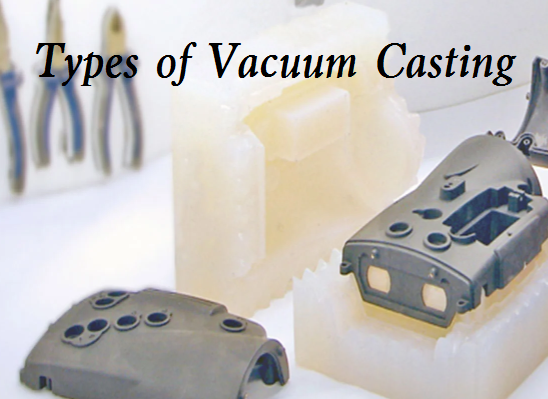Vacuum casting is a process using a ventilated mold. The molten metal flows into the mold by air pressure, and then removes the air to form a vacuum. This casting method is mainly used for small parts or jewelry with exquisite details. What are different types of vacuum casting and what are the benefits to use them?

What is Vacuum Casting?
Vacuum molding is a kind of physical molding method, which combines vacuum technology with sand mold casting, seals the mold cavity surface and back of the sand mold with plastic film, and generates negative pressure with the help of vacuum pump, causing the internal and external pressure difference of the sand mold to make the mold sand firm and form. After placing the sand core, closing the mold, casting, and waiting for the casting to solidify, remove the negative pressure or stop pumping, and the mold sand will then collapse to obtain the casting. According to the current application fields, it can be divided into vacuum sealing molding (V method) and full mold vacuum casting (FV method). Its advantages are:
– Moderate vacuum degree, high mold cavity compactness and high casting quality.
– Vacuum casting combined with computer mold flow analysis and simulation can predict the occurrence of casting defects. For the design of mold making scheme, it can greatly save time and improve production efficiency.
Types of Vacuum Casting - Benefits of Different Vacuum Casting Processes
Vacuum casting can be roughly divided into vacuum suction casting, vacuum low-pressure casting and vacuum counter pressure casting:
1. Vacuum suction casting
Place the mold in a closed container and extract the air from the mold to create a certain negative pressure in the mold, causing the liquid metal to be sucked into the mold cavity. When the inner sprue of the casting solidifies, remove the negative pressure and make the non solidified metal liquid in the vertical sprue flow back to the molten pool. Its advantage is to improve the filling ability of the alloy liquid, and the minimum wall thickness of the suction casting casting can reach o 2mm, and the casting area is 300mm2, while reducing defects such as pores and slag inclusions. It is suitable for producing thin and fine small precision castings, especially steel castings (including stainless steel). Its advantages are:
(1) Vacuum suction casting is conducive to the elimination of gas in the mold, inhibiting the generation of turbulent flow and entrainment, overcoming the disadvantages of low-pressure casting and counter pressure casting, and significantly improving the filling capacity of molten metal.
(2) Due to the improvement of filling capacity during vacuum suction casting, the casting temperature of molten metal can be 20~30 ℃ lower than that during gravity casting.
(3) Castings with large wall thickness difference, thin wall and high quality requirements can be cast.
(4) By selecting the appropriate rate of vacuum change and controlling the speed of molten metal entering the mold cavity, a stable filling effect can be obtained.
2. Vacuum low pressure casting
Vacuum low-pressure casting is to vacuum the mold in the process of pressure filling. After filling, the pressure is maintained to make the casting crystallize and solidify under constant pressure, and the casting is fully fed, so the structure of the casting is dense and the mechanical properties are improved. This method is mostly used for precision casting of Al, Mg alloy castings. Its advantages are as follows:
(1) The existence of vacuum negative pressure can compact the mold sand and increase the strength of the mold.
(2) The vacuum degree is moderately increased to shorten the filling time, which not only accelerates the filling speed, but also is stable.
(3) Vacuum low-pressure casting can speed up the fluidity of aluminum alloy at low temperature, avoid the gettering phenomenon of aluminum alloy caused by high-temperature casting, and increase the pinhole defects of castings.
(4) The casting has good formability, which is conducive to the formation of castings with clear outline and smooth surface and large thin-wall castings.
(5) The casting has dense structure and high mechanical properties.
(6) Generally, no riser is needed, which greatly improves the yield of molten metal, usually up to 90%.
(7) The working environment is good and the equipment is simple, which is conducive to mechanization and automation.
3. Vacuum counter pressure casting
Vacuum counter pressure casting is mainly to seal the resistance holding furnace and the mold, and inject compressed air with high pressure, such as 500kPa, into the sealing cover. At this time, because the pressure inside the mold and the crucible is equal, the liquid metal will not rise, and then add 50kPa pressure on the metal liquid surface, and the liquid metal will rise and fill the mold cavity. It is especially suitable for the production of complex thin-wall castings, but the equipment is relatively large and the operation is troublesome, so it can only be applied when there are special requirements. Its advantages are as follows:
(1) Compared with traditional gravity casting and vacuum suction casting, vacuum counter pressure casting shows a good mold filling ability on 1mm thick sheet samples.
(2) The castings have dense crystalline structure and mechanical properties. In terms of strength properties, the castings are about 20% – 25% higher than vacuum suction casting and gravity casting, and the elongation is about 50%.
(3) Vacuum die casting can effectively reduce the porosity of die castings and increase the density of castings by more than 1%.

